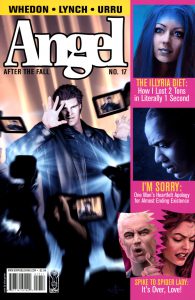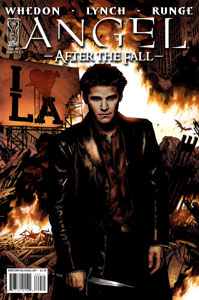After the “First Night” interlude (Issues 6-8), IDW’s “Angel” returns to the main storyline of “After the Fall” having lost its momentum. Although still plotted by Joss Whedon and scripted by Brian Lynch, the arc feels like it is treading water, with a lot of talking. It also doesn’t help that Franco Urru is mostly absent from Issues 9-14, as he was working on “Spike: After the Fall.” Before his return for the grand finale, there’s a shortage of dynamism in the panels.
The cliffhanger entering Issue 9 is whether there is any of Fred in Illyria. This never struck me as a mystery, since Season 5 makes it abundantly clear that Illyria completely erases Fred’s existence when taking over her body. We are told Fred isn’t even on a spiritual plane; Illyria obliterated her. While Dark Horse’s “Angel & Faith” Season 10 would later challenge this certainty again, “After the Fall” stays the course on this point. Still, I like the notion that Illyria wants to behave like Fred, because she desires the love that Wesley, Gunn and others showed to Fred. This will ultimately be the key to defeating Illyria when she tries to destroy the universe.
The concept behind Gunn’s journey is solid: He wants to prove he can be good despite being a soulless vampire. Whedon and Lynch portray this honestly, as Gunn fails at every turn to be good, and readers can see he is driven by a desire for attention and power, even if Gunn can’t see this. But Gunn’s back-and-forth about whether or not to kill Angel, and whether or not to destroy the world or rule it, gets old. In general, there’s too much of characters appealing to various higher powers – from W&H to the Powers That Be to a vague sense of destiny – about what actions they should take. This reminds me of the prophecy-driven Season 3 and the goddess-driven Season 4, the two weakest of “Angel’s” TV seasons.
The first six issues of this batch also chronicle the restoration of Gwen’s powers and introduce a trio of unnamed Slayers who had been imprisoned by Gunn and then team up with Spike. Lynch finds a nice use for Cordelia’s ghost, who talks Angel back from the brink of death. Still, I feel like Issues 9-14 could’ve been condensed into an issue or two.
Spike, although physically present and delivering requisite quips, fades as a character with personal stakes. Admittedly, I have to reread “Spike: After the Fall,” which should give me a greater appreciation for his relationships with Illyria and Spider and the women warrior clan.
Kate is not involved in the action, despite getting a short story in “First Night.” Lorne disappears from the narrative, but I’m not stressing over that. In an interview at the back of Issue 16, Lynch admits that Nina played much less of a role than he originally intended. I’d rather a few characters get great arcs rather than everyone getting a little something. It’s understandably hard to service this sprawling cast.


With Urru back on board, Issues 15-17 restore the action and emotional momentum, including Angel crying over the corpse of his son, Connor. Plus, Illyria, Gunn and – if you’re paying close attention – Groo also bite the dust.
It’s a testament to Lynch’s and Whedon’s world-building in “After the Fall” that it doesn’t feel like a cheat when our heroes maneuver Wolfram & Hart into resetting the timeline back to the point of the “Not Fade Away” (5.22) cliffhanger. For one thing, we always knew this was an alternate dimension; it’s confirmed when we see Spike’s friends from the “Spike” comics are in Las Vegas seeing a normal Los Angeles portrayed on TV.
For another, this isn’t precisely a rerun for Angel, where he’s the only one who remembers the alternate timeline, like when he spends a century in Hell between Seasons 2 and 3 of “Buffy,” or when only he remembers his perfect day with Buffy in “I Will Remember You” (1.8). In Issues 16-17, we see that everyone in Los Angeles remembers their time in Hell. Connor even knows he has come back to life.
Rather, “After the Fall” is more like a drawn-out version of “The Wish” (“Buffy” 3.9). Angel and company experience the hell (literally, in this case) of an alternate reality, and it teaches them what to do when they get a second chance. The first thing Angel does after the reset – rather than pursuing the dragon, as he does the first time around — is to rescue Gunn from being turned.
Plus, there is still emotion to it all, since the upending of W&H means Wesley is truly gone, even as a ghost. And there’s mystery: In this L.A. that’s restored to normal, the local branch of W&H is missing.
And there’s the intrigue of the fact that we’re entering a new zeitgeist, something that thematically lines up the end of “After the Fall” with the end of “Buffy” Season 7. Although this story takes place well after Buffy and Willow activate thousands of Slayers, “After the Fall” feels like a final statement on the era of “Angel” where he’s an under-the-radar hero, just as “Buffy” Season 7 is a closing statement of that era for Buffy.
From now on, in a mirror to Buffy’s experiences in Season 8, Angel is a celebrity superhero; a fan even takes a selfie with him. While I don’t necessarily love this new reality, I already know it exists from the “Buffy” comics, and I appreciate the way “Angel” squares up.
Although “After the Fall” never puts a spotlight on experiences that might drive Angel to devise his Twilight persona, a reader can surmise that Angel is now more susceptible to Whistler and other prognosticators warning him about a hellish future if he doesn’t follow their plan for avoiding it. It’s not essential that Angel moves into the Twilight headspace yet, though. “After the Fall” is over, but IDW’s “Angel” series will continue through Issue 44.
Click here for an index of all of John’s “Buffy” and “Angel” reviews.

